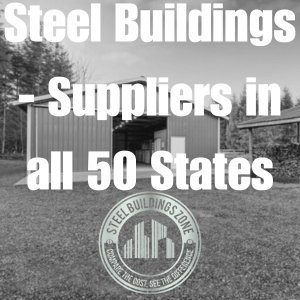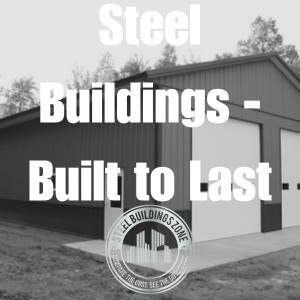
Understanding the Cost-Benefit Analysis of Steel Buildings
In the realm of construction and large-scale projects, the choice of materials plays a pivotal role in determining both the initial investment and long-term viability of the project. Steel buildings have become increasingly popular, and understanding their cost-benefit analysis is crucial for project managers and developers. This blog post will delve into the various aspects that make steel buildings a cost-effective choice in the long term.
Initial Investment vs. Long-Term Savings
While the initial cost of constructing a steel building may be higher than some traditional materials, it’s important to consider the long-term savings it offers.
- Durability: Steel’s durability leads to fewer repairs and less maintenance over the building’s lifespan. Unlike wood, steel is not susceptible to rot, pests, or mold, which can result in significant savings on repair costs.
- Speed of Construction: Steel buildings are often quicker to erect compared to traditional construction methods. This speed translates into reduced labor costs and a quicker return on investment as the building can be operational in a shorter timeframe.
When considering the construction of a steel building, it’s important to weigh the initial investment against the potential long-term savings. This cost-benefit analysis is crucial for businesses to understand the true value of their investment.

Understanding the Initial Investment
The initial cost of constructing a steel building encompasses several components. This includes the price of raw materials, design and engineering services, labor costs for construction, and any additional features or customization. While the upfront cost can be higher compared to traditional construction materials, it’s essential to consider the quality, durability, and the range of benefits that steel provides.
Long-Term Savings: A Deeper Insight
Over time, the investment in a steel building can prove to be more economical when compared to other materials. This long-term financial efficiency is driven by several factors.
Durability and Reduced Maintenance Costs
Steel buildings are renowned for their durability and strength, withstanding harsh weather conditions and environmental stressors better than many other materials. This resilience translates into lower maintenance costs over the years. The need for repairs, repainting, and structural overhauls is significantly reduced, which can amount to substantial savings in the long run.
Energy Efficiency and Operating Costs
Modern steel buildings can be designed for optimal energy efficiency. With proper insulation and energy-efficient design, these buildings maintain internal temperatures more effectively, leading to reduced costs in heating and cooling. This energy efficiency not only saves money but also aligns with environmental sustainability goals.
Speed of Construction and Reduced Labor
The construction of steel buildings, often involving pre-engineered or modular components, is typically faster than traditional construction methods. This speed translates into lower labor costs and a quicker return on investment as the building can be operational in a shorter time frame. The efficiency of the construction process also reduces the likelihood of unexpected costs or delays that can impact the overall budget.
Adaptability and Future-proofing
Steel buildings offer unparalleled flexibility in terms of design and expansion. They can be easily modified, expanded, or repurposed, which adds to their long-term value. This adaptability means businesses can avoid the costs associated with constructing new buildings as their needs change over time.
Resale Value and Asset Appreciation
The longevity and low maintenance nature of steel buildings can enhance their resale value. They are often considered a valuable asset in the real estate market, especially when well-maintained. This potential for asset appreciation should be factored into the long-term financial considerations.

Durability and Maintenance
The durability and maintenance of a steel building are key factors in its long-term value and cost-effectiveness. Understanding these aspects can help businesses and project managers appreciate the full spectrum of benefits associated with steel structures.
Steel’s Inherent Durability
Steel’s natural strength and resilience contribute significantly to the longevity of buildings constructed with it. This material is capable of withstanding extreme environmental conditions, from heavy snow and wind to earthquakes and fires. Such durability ensures that steel buildings remain structurally sound and functional for many years, far exceeding the lifespan of traditional building materials in many cases.
Resistance to Common Damaging Factors
Unlike wood or concrete, steel is impervious to many common sources of damage:
- Pest Resistance: Steel is not susceptible to termites or other wood-boring insects that can compromise the structural integrity of wooden buildings.
- Rot and Mold Resistance: Steel does not rot, warp, or encourage the growth of mold, which can be a significant issue in other types of construction, especially in damp or humid environments.
- Fire Resistance: Being non-combustible, steel buildings offer enhanced fire resistance compared to structures made from flammable materials like wood, reducing the risk of fire damage.
Low Maintenance Requirements
The durability of steel directly translates into lower maintenance requirements. This aspect is particularly beneficial from a financial standpoint:
- Minimal Upkeep: Steel buildings typically require less frequent and less intensive maintenance routines. The exteriors of these buildings, especially if treated with modern protective coatings, rarely need more than basic cleaning.
- Long-Term Cost Savings: The reduced need for regular maintenance helps in cutting down the long-term costs associated with building upkeep. For businesses, this means more resources can be allocated to core operations rather than building maintenance.
Addressing Corrosion
While steel is a robust material, it is not entirely free from maintenance considerations. Corrosion can be a concern, particularly in certain environmental conditions:
- Preventive Treatments: Modern steel buildings often incorporate protective coatings and galvanization techniques to guard against rust and corrosion.
- Regular Inspections: Conducting periodic inspections for any signs of corrosion or damage and addressing them promptly can further extend the life of a steel building.

The Impact of Maintenance on Life Cycle Costs
When evaluating the life cycle costs of a building, the reduced maintenance needs of steel structures play a significant role. These savings, over time, contribute significantly to the overall cost-effectiveness of the investment in a steel building.
- Resilience to Wear and Tear: Steel is highly resistant to many of the factors that can degrade other materials, such as pests, rot, mold, and fire. This resilience translates to a longer lifespan and reduced need for repairs.
- Low Maintenance Requirements: Unlike wood that may need regular treatments or concrete that can crack and degrade, steel buildings require minimal maintenance. This not only saves on the cost of repairs and upkeep but also reduces the time and effort spent on maintenance work.
Energy Efficiency and Sustainability
- Energy Efficiency: Steel buildings can be highly energy-efficient. With proper insulation, they maintain interior temperatures more effectively, leading to reduced heating and cooling costs.
- Sustainability: Steel is one of the most recycled materials in the world, and its recyclability contributes to its sustainability. The ability to recycle steel at the end of its life further reduces the environmental impact and can offer cost savings in terms of disposal.
Construction Time and Labor Costs
- Faster Construction: Steel buildings are often pre-engineered and can be erected much faster than traditional structures. This speed in construction not only saves time but also significantly reduces labor costs.
- Reduced Labor Needs: The prefabricated nature of steel buildings means that less on-site labor is needed, which can result in lower construction costs.
Flexibility and Adaptability
Steel buildings offer a level of flexibility that can be a major cost-saving factor, particularly for businesses with evolving needs.
- Modular Design: The modular design of many steel buildings allows for easy expansion or modifications. This adaptability can be a significant advantage as it reduces the need for new construction when expansion is required.
- Wide Range of Uses: From warehouses and factories to offices and retail spaces, steel buildings are suitable for a wide range of uses. This versatility means they can be repurposed as needed, providing cost savings over time.
Long-Term Value and Asset Appreciation
- Asset Appreciation: Well-maintained steel buildings can maintain or even increase their value over time, making them a sound investment.
- Insurance Advantages: Due to their durability and resistance to fire, steel structures often qualify for lower insurance premiums, contributing to long-term cost savings.
The cost-benefit analysis of steel buildings reveals their true value lies in long-term savings. From lower maintenance and energy costs to faster construction times and flexibility, steel buildings offer a financially sound choice for a wide range of construction needs. For business owners and project managers, understanding these benefits is key to making informed decisions about their construction investments.

Longevity and Resale Value
One of the most compelling arguments for choosing steel buildings is their impressive lifespan. When properly maintained, a steel structure can last several decades, often outliving similar structures made from alternative materials. This longevity contributes significantly to their overall cost-effectiveness.
- Enduring Material: The inherent strength and resilience of steel against environmental factors like wind, rain, snow, and seismic activity mean that steel buildings maintain their structural integrity over a long period.
- Future-proofing: Steel’s ability to withstand the test of time also means it’s a future-proof investment. As needs and technologies evolve, the building can be easily updated or repurposed, rather than requiring a complete rebuild.
The long lifespan of steel buildings also contributes positively to their resale value. A well-maintained steel structure can be an attractive asset in the real estate market, often commanding higher resale values compared to traditional buildings.
Cost Benefits in Customization and Aesthetics
Steel buildings offer significant advantages in terms of customization and aesthetics, which can also translate into cost benefits.
- Design Flexibility: The versatility of steel allows for innovative designs and custom layouts. This flexibility means that businesses can design buildings that precisely meet their needs, avoiding costly modifications or additions down the line.
- Aesthetic Appeal: Modern steel buildings are not just functional; they can be aesthetically pleasing too. With a variety of finishes and facades available, steel buildings can be designed to make a strong architectural statement or blend seamlessly into any environment.

Risk Mitigation
Investing in a steel building also means mitigating several risks associated with construction and property ownership.
- Reduced Construction Risk: The predictability and precision of pre-engineered steel construction reduce the risks of project overruns and unexpected costs during the building phase.
- Safety and Compliance: Steel’s fire-resistant qualities and ability to meet stringent building codes enhance safety and compliance, reducing the risk of costly legal or insurance issues.
Environmental Impact and Regulatory Compliance
- Eco-friendly Choice: As an eco-friendly material, steel aligns with green building standards and can contribute to obtaining certifications like LEED. Using recycled steel further minimizes the environmental footprint.
- Regulatory Compliance: Steel’s durability and non-combustible nature often make it easier to meet building codes and safety regulations, simplifying compliance and potentially reducing associated costs.
The cost-benefit analysis of steel buildings extends beyond initial construction expenses. The durability, energy efficiency, flexibility, and low maintenance needs of steel structures make them a financially sound choice in the long term. Additionally, their aesthetic appeal, safety features, and environmental friendliness add to their value proposition, making them a wise investment for various applications and industries.
Explore the possibilities and long-term advantages with our expert team. Steel Buildings Zone is here to help with free and reliable quotes to get you started on your steel building journey.
COMPARE QUOTES
Leave a Reply